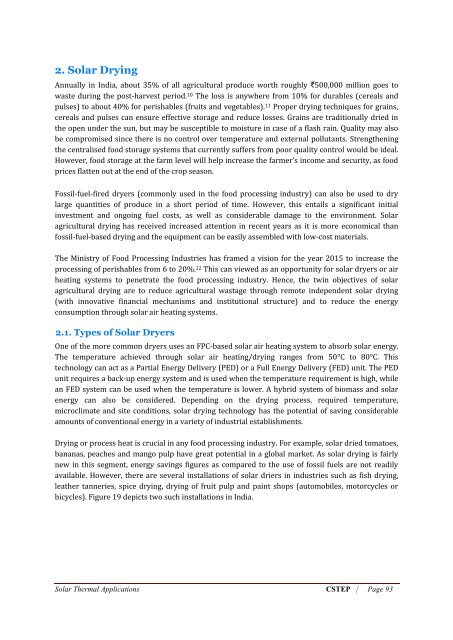Harnessing Solar energy, Options for India
A study on harnessing solar energy options for India was conducted recently by Shakti Sustainable Energy Foundation, Climate works Foundation and SSN foundation. Supporting this study it has been concluded that solar energy can play a big role in providing electricity to rural areas and thus has been included in India’s rural electrification policy. See more at: http://shaktifoundation.in/report/harnessing-solar-energy-options-for-india/
A study on harnessing solar energy options for India was conducted recently by Shakti Sustainable Energy Foundation, Climate works Foundation and SSN foundation. Supporting this study it has been concluded that solar energy can play a big role in providing electricity to rural areas and thus has been included in India’s rural electrification policy. See more at: http://shaktifoundation.in/report/harnessing-solar-energy-options-for-india/
Create successful ePaper yourself
Turn your PDF publications into a flip-book with our unique Google optimized e-Paper software.
2. <strong>Solar</strong> Drying<br />
Annually in <strong>India</strong>, about 35% of all agricultural produce worth roughly `500,000 million goes to<br />
waste during the post-harvest period. 10 The loss is anywhere from 10% <strong>for</strong> durables (cereals and<br />
pulses) to about 40% <strong>for</strong> perishables (fruits and vegetables). 11 Proper drying techniques <strong>for</strong> grains,<br />
cereals and pulses can ensure effective storage and reduce losses. Grains are traditionally dried in<br />
the open under the sun, but may be susceptible to moisture in case of a flash rain. Quality may also<br />
be compromised since there is no control over temperature and external pollutants. Strengthening<br />
the centralised food storage systems that currently suffers from poor quality control would be ideal.<br />
However, food storage at the farm level will help increase the farmer’s income and security, as food<br />
prices flatten out at the end of the crop season.<br />
Fossil-fuel-fired dryers (commonly used in the food processing industry) can also be used to dry<br />
large quantities of produce in a short period of time. However, this entails a significant initial<br />
investment and ongoing fuel costs, as well as considerable damage to the environment. <strong>Solar</strong><br />
agricultural drying has received increased attention in recent years as it is more economical than<br />
fossil-fuel-based drying and the equipment can be easily assembled with low-cost materials.<br />
The Ministry of Food Processing Industries has framed a vision <strong>for</strong> the year 2015 to increase the<br />
processing of perishables from 6 to 20%. 12 This can viewed as an opportunity <strong>for</strong> solar dryers or air<br />
heating systems to penetrate the food processing industry. Hence, the twin objectives of solar<br />
agricultural drying are to reduce agricultural wastage through remote independent solar drying<br />
(with innovative financial mechanisms and institutional structure) and to reduce the <strong>energy</strong><br />
consumption through solar air heating systems.<br />
2.1. Types of <strong>Solar</strong> Dryers<br />
One of the more common dryers uses an FPC-based solar air heating system to absorb solar <strong>energy</strong>.<br />
The temperature achieved through solar air heating/drying ranges from 50°C to 80°C. This<br />
technology can act as a Partial Energy Delivery (PED) or a Full Energy Delivery (FED) unit. The PED<br />
unit requires a back-up <strong>energy</strong> system and is used when the temperature requirement is high, while<br />
an FED system can be used when the temperature is lower. A hybrid system of biomass and solar<br />
<strong>energy</strong> can also be considered. Depending on the drying process, required temperature,<br />
microclimate and site conditions, solar drying technology has the potential of saving considerable<br />
amounts of conventional <strong>energy</strong> in a variety of industrial establishments.<br />
Drying or process heat is crucial in any food processing industry. For example, solar dried tomatoes,<br />
bananas, peaches and mango pulp have great potential in a global market. As solar drying is fairly<br />
new in this segment, <strong>energy</strong> savings figures as compared to the use of fossil fuels are not readily<br />
available. However, there are several installations of solar driers in industries such as fish drying,<br />
leather tanneries, spice drying, drying of fruit pulp and paint shops (automobiles, motorcycles or<br />
bicycles). Figure 19 depicts two such installations in <strong>India</strong>.<br />
<strong>Solar</strong> Thermal Applications CSTEP | Page 93

















